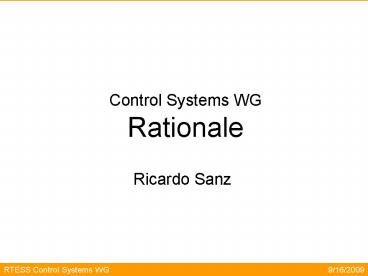Control Systems WG Rationale - PowerPoint PPT Presentation
1 / 30
Title:
Control Systems WG Rationale
Description:
hydraulic power plants. 7/27/09. RTESS Control Systems WG ... Of major importance are the relations with: AD, MARS, Systems Engineering, MDA and Simulation. ... – PowerPoint PPT presentation
Number of Views:55
Avg rating:3.0/5.0
Title: Control Systems WG Rationale
1
Control Systems WG Rationale
- Ricardo Sanz
2
Complexity Raising
- In Control Systems
3
Complex Control Systems
- Control systems are software-intensive
applications that are becoming extremely complex
as new functionality is required from them. - Software complexity is a major engineering
challenge and distributed object technology has
proved useful in dealing with this problem.
4
Software Control Context
- Control systems do perform a dynamical
interaction with real world entities (they are
closed loop systems). - Their complexity can range from a simple
thermostat or pacemaker to an Airbus AFCS or a
country-wide energy management system. - Large control systems do pose problems of wider
and deeper scope than many other software
systems e.g. distribution, hard real-time
behavior, fault-tolerance, embeddedness, long
life-span, reliability, scalability,
composability, etc. - The approach needed by control systems
engineering is integrative (many issues now
scattered in several technological
standardization processes).
5
Plant-wide Control
MIS
Safety
Enterprise Network
Business Management
Data Storage
Process Control
Process Operation
Control Network
Process Management
Field Configuration
Fieldbus
Sensing and Acting
Field Management
Continuous Process Plant
6
Total-Ship Systems
Total Ship CC Center
7
Car Control Systems
8
Design Challenges
- Predictability
- Performance
- Scalability
- Openness
- Coordination
- Transparency
- Naming
- Cost
- Consistency
- Failure handling
- Security
- Heterogeneity
- Mobility
- Load sharing
- Footprint
- etc.
9
Why CORBA ?
ps.getADC()
- interface PS
- ADC double RO
- DAC double RW
- status bits RO
- on() void
- off() void
- RampedPS PS
- start() void
- stop() void
ps.getDAC()
ps.setDAC()
ps.off()
ps.getStatus()
Physical/Logical Devices Map to ActiveObjects
10
Why CORBA ?
- Reasons for using CORBA in control systems
engineering - Standardization
- Modularity
- Reusability
- Composability
- Complexity handling
- Dealing with change
11
CORBA in Control Systems
- Some Examples
12
Synchronized Pendulums
Simplex ControllerLynx OSNode A ILU ORB
Simplex ControllerLynx OSNode B ILU ORB
outer loop controlCORBA
SunOSNode C ILU ORB
13
Robot Teleoperation
14
Plant-wide Risk Management
15
Real-time WAN video
- Remote operation of hydraulic power plants
Camera
User Interface
16
Open Weapon Systems
Browser
JTIDS
Collaboration
C4I
Collaboration
Application
Server
Simulation
Client
Controls
Displays
C2
F-15
Virtual Target
Quality Object
Folder
Framework
Adaptive
Quality of Service
Management
Resource Mgmt
Object Request Broker
Pluggable Protocol
Pluggable Protocol
Link 16 Interface Software
Link 16 Interface Software
Link 16
17
Strategic Process Control
Operator
Wrappers
UI
IRDB
CIM21
LAB
OI
Object Request Broker
PPSI
AMOA
QDED
IM
VM
Support
Core Functions
18
Substation Automation
Doorbell
GPS
Pushbutton
Operator Terminal
Configuration Terminal
Camera
10BaseT
10BaseT
IED-1
IED-2
10BaseFL
Switch
19
Smart Transducers
- TTP/A fieldbus network with 1 master
- 1 node for sensor fusion and navigation
- 15 smart transducers (9 actuators/6 sensors)
CORBA
World
CORBA
-
Gateway
Active
Active
Master
Master
Cluster A
Cluster B
20
OMG Control Systems WG
- Rationale
21
CORBA in Control Systems
- CORBA
- well-suited
- concept proved in other projects
22
Work Focus
- The focus of the work is distributed/modular
control applications, i.e. applications where a
distributed information system closes a control
loop. - Timing is critical in these types of software
applications due to dynamic effects that can be
derived from delays or jitter due to the
software/hardware path. - Standardization is a valuable asset in the path
to total plant integration
23
The CSWG Position
- Present-day CORBA technology
- CORBA 3.0
- RT-CORBA 1.0, 2.0
- GIOP / IIOP / Extensible Transports
- UML / MDA
- Other specs (Real-time data distribution,
historical data, ). - is not enough for some control applications.
24
Closing Loops
Plant
25
Network Control
26
Sample Requirements
- Constant delay between sampling and actuation
- Synchronization of multiple sampling and/or
actuation - Jitter minimization
- Reliable ordered group communication
- Etc.
27
The Road Ahead
- CORBA (Distributed/Modular) Control Systems
- Hard real-time behavior
- Consideration for dynamics of reality
- Model-based (system/environment) construction
- Formal verification / Fault-tolerance
- Maintainability Long life-span (10-40 years)
- Design patterns Cost-effective, predictable
engineering - Scalability and Dependable Composability
- Systems engineering (complexity handling)
- etc.
28
CSWG Charter (I)
- The purpose of the Control Systems WG is to
foster the availability and suitability of OMG
specifications in relation with the construction
of distributed control systems. - The technology needed falls more-or-less inside
RTESS scope, but the CSWG is basically domain
oriented but with a cross-cutting approach
(manufacturing, utilities, aerospace, automotive,
C4I, transport, etc). Of major importance are the
relations with AD, MARS, Systems Engineering,
MDA and Simulation.
29
CSWG Charter (II)
- The main activity of the WG should be catalytic,
encouraging existing groups in the OMG to
consider if their specs are useful to control
systems and trying to redirect their evolution. - The CSWG will address these issues by means of
three main types of activities in themes relevant
to control systems engineering - Foster new specifications for the controls domain
(with an eye on other bodies specs ISO, IEC,
ISA, IEEE, etc). - Catalyze OMG specification processes (new
existing) in different groups (including core OMG
specs). - Increase coherence of specification efforts in
different OMG groups.
30
Thats all!
- CSWG rationale































